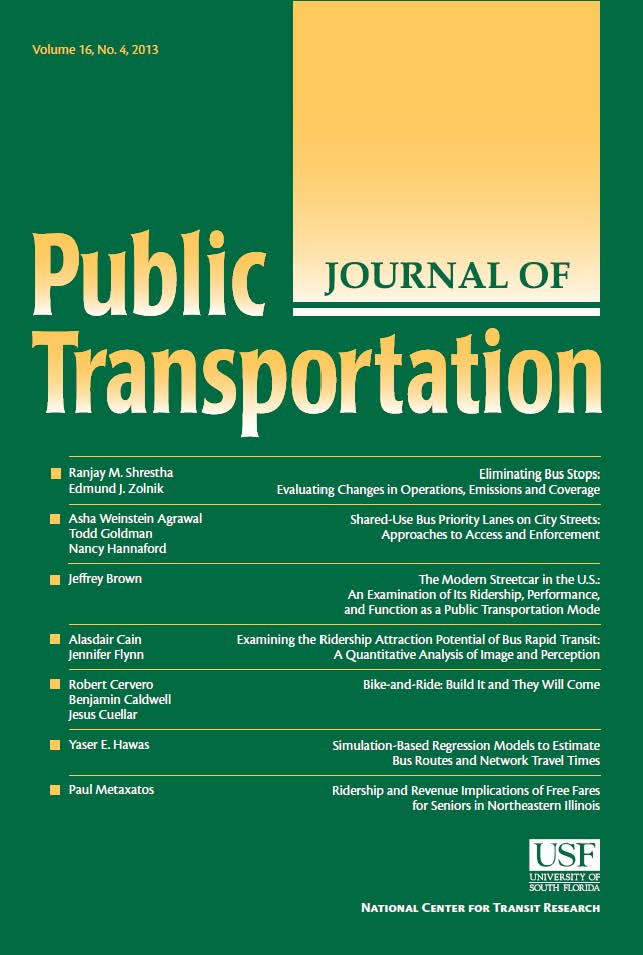Evaluating the effects of fare characteristics on fare equity: A scoping review
IF 2
4区 工程技术
Q3 TRANSPORTATION
引用次数: 0
Abstract
While public-transit fares can represent barriers to some people to use public-transit systems, they remain a major source of funding for operating it. Given the ubiquitous nature of fares in public-transit systems worldwide, understanding how characteristics of fare structures affect the distribution of fare burden (i.e., fare equity) is crucial. To do so we conducted a scoping review of the current literature on public-transit fare equity. We defined fare equity in the form of vertical equity (based on the ability-to-pay principle) and market equity (based on the beneficiary-pay principle). We then screened through 511 unique studies, retaining 24 for analysis. Findings were grouped based on fare attributes (e.g., distance-, time-, service- and user-based fare modulations), fare type and fare integration before combining results in a conceptual model. Distance-, time- and service-based fares were shown to have a positive effect on market equity while only income-based fares always positively impacted vertical equity. User-based fares have shown clear negative effects on market fare equity. The effects of most fare characteristics on fare equity were either not well researched or dependent on local contexts. Lastly, a lack of assessment of the synergies between fare characteristics in their effect on fare equity was also observed. Potential opposite effects of fare characteristics on vertical and market fare equity points to the necessity for public-transit agencies to choose which form of fare equity to promote. Recommendations for practitioners and researchers based on our findings are provided to guide the field of fare equity forward.
评估票价特征对票价公平的影响:范围审查
虽然公共交通票价可能成为一些人使用公共交通系统的障碍,但它们仍然是运营公共交通系统的主要资金来源。鉴于全球公共交通系统票价普遍存在,了解票价结构的特征如何影响票价负担的分布(即票价公平)至关重要。为此,我们对目前有关公共交通票价公平的文献进行了范围审查。我们以垂直公平(基于支付能力原则)和市场公平(基于受益-支付原则)的形式定义票价公平。然后,我们筛选了511项独特的研究,保留了24项用于分析。调查结果根据票价属性(例如,基于距离、时间、服务和用户的票价调整)、票价类型和票价整合进行分组,然后将结果合并成一个概念模型。以距离、时间和服务为基础的票价对市场公平有积极影响,而只有以收入为基础的票价总是对垂直公平有积极影响。以用户为基础的票价对市场票价公平产生了明显的负面影响。大多数票价特征对票价公平的影响要么没有得到很好的研究,要么取决于当地的情况。最后,还观察到缺乏对票价特征对票价公平影响的协同效应的评估。票价特征对垂直和市场票价公平的潜在相反影响表明,公共交通机构有必要选择推广哪种形式的票价公平。根据我们的研究结果,为从业者和研究人员提供了建议,以指导票价公平领域的发展。
本文章由计算机程序翻译,如有差异,请以英文原文为准。
求助全文
约1分钟内获得全文
求助全文
来源期刊

Journal of Public Transportation
TRANSPORTATION-
CiteScore
6.40
自引率
0.00%
发文量
29
审稿时长
26 days
期刊介绍:
The Journal of Public Transportation, affiliated with the Center for Urban Transportation Research, is an international peer-reviewed open access journal focused on various forms of public transportation. It publishes original research from diverse academic disciplines, including engineering, economics, planning, and policy, emphasizing innovative solutions to transportation challenges. Content covers mobility services available to the general public, such as line-based services and shared fleets, offering insights beneficial to passengers, agencies, service providers, and communities.
 求助内容:
求助内容: 应助结果提醒方式:
应助结果提醒方式:


